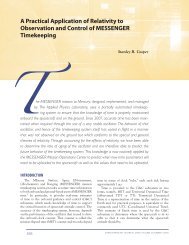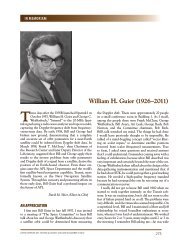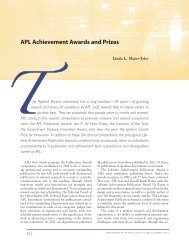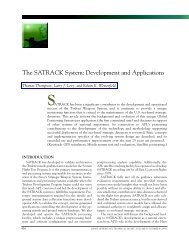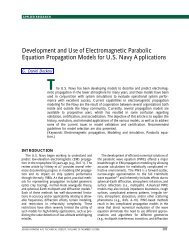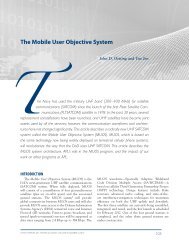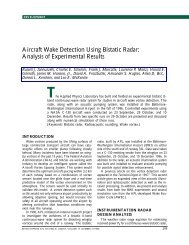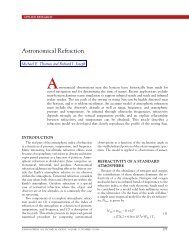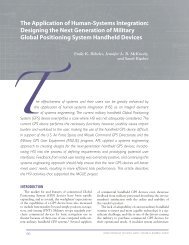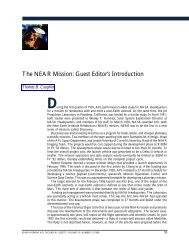Operational Evaluation for Evolutionary Sonars - Johns Hopkins ...
Operational Evaluation for Evolutionary Sonars - Johns Hopkins ...
Operational Evaluation for Evolutionary Sonars - Johns Hopkins ...
You also want an ePaper? Increase the reach of your titles
YUMPU automatically turns print PDFs into web optimized ePapers that Google loves.
B. O. BATES, R. CALHOUN, AND D. E. GRANT<br />
Bearing<br />
the last 20 minutes of the test time. The right side of the<br />
fi gure shows the footprint computed at different times<br />
during the test run. The red outline is the footprint, i.e.,<br />
a plot of FOM range versus bearing. It varies with time<br />
because the ambient noise directionality, and hence the<br />
beam noise, varies. The blue dot indicates the position<br />
of the target (from navigation reconstruction) relative<br />
to the sonar receiver. Note that when the target is visible<br />
on the sonar display, it is inside the footprint. This<br />
comparison is a good qualitative verifi cation that the<br />
footprints accurately represent sonar per<strong>for</strong>mance.<br />
A quantitative verifi cation can be done by computing<br />
the signal excess (SE) as follows:<br />
SE = SL TL() SG BN(, t) RD .<br />
Figure 3 shows a comparison of the signal excess with<br />
a bearing versus time display that is similar to what a<br />
sonar operator uses. The signal excess was computed<br />
post-analysis using the source level <strong>for</strong> the target test<br />
ship and, at each time slice, using noise from the beam<br />
that points along the sensor to the target bearing as well<br />
as the TL (from a model) that was computed along the<br />
sensor-to-target bearing. This bearing was determined<br />
0<br />
10<br />
20<br />
30<br />
40<br />
50<br />
60<br />
Figure 2. Example comparison of footprints (right) with a sonar display (left).<br />
Time<br />
Minute 25<br />
Minute 40<br />
Minute 45<br />
Minute 54<br />
from navigation reconstruction and<br />
changes as a function of time.<br />
At the beginning of the test run<br />
in Fig. 3 (bottom of the plots), the<br />
test ship is not observable on the<br />
sonar display (left), and the computed<br />
signal excess is a negative<br />
number. Just prior to minute 30, the<br />
test ship is barely observable on the<br />
sonar display, and the signal excess<br />
crosses over from negative to positive.<br />
In the latter part of the test run,<br />
the target is clearly visible and the<br />
signal excess is high. This quantitative<br />
comparison provides verifi cation<br />
that terms in the sonar equation are<br />
correctly accounted <strong>for</strong>. Reliable<br />
footprints can be computed with the<br />
sonar equation by setting SE = 0.<br />
In the examples shown in Figs.<br />
2 and 3, agreement between target<br />
holding predicted by the footprint<br />
calculation and holding on the<br />
display is verifi ed. The RD may be<br />
adjusted to cause this agreement<br />
(assuming there are no biases in<br />
other parts of the equation), and<br />
then that RD can be used to assess<br />
how well the sonar system works at<br />
making targets visible to the opera-<br />
tor. This is called the system RD.<br />
During testing, the operator logs when he gained and<br />
lost the test ship and adjustments can be made to the<br />
RD accordingly. This is the operator RD.<br />
The operator RD and system RD differ in that various<br />
factors can cause the operator RD to be higher (worse)<br />
than the system RD. These factors include operator<br />
training, alertness, fatigue, and whether the operator<br />
was actually looking at the display when the target fi rst<br />
appeared. Having the two RD values allows us to use<br />
footprint calculations to assess the per<strong>for</strong>mance of the<br />
machine (sensor, signal processing, and displays) only,<br />
versus the machine and operator combination.<br />
APPLICATION TO FIELDS<br />
AND TOWED ARRAYS<br />
Sonar testing usually involves several days at sea,<br />
but a test target plat<strong>for</strong>m (with known source levels)<br />
is involved on only a few of those days. The footprints<br />
are validated with the test target plat<strong>for</strong>m. Footprints<br />
from the entire sea test, using beam noise data from the<br />
test, can then be used to assess the variation in the per<strong>for</strong>mance<br />
of the system over several days. This cannot<br />
be done within the limited time that a test target<br />
is available.<br />
362 JOHNS HOPKINS APL TECHNICAL DIGEST, VOLUME 23, NUMBER 4 (2002)




